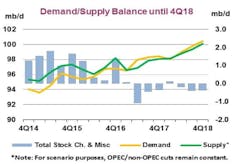IEA raises global oil demand estimate for 2018
Global oil demand is expected to rise 1.5 million b/d to 99.3 million b/d in 2018, according to the International Energy Agency’s most recent Oil Market Report. This represents a 90,000-b/d increase compared with last month’s report.
In the March OMR, oil demand of countries in the Organization for Economic Cooperation and Development has been revised up by 240,000 b/d in 2018, reflecting the impact of recent strong data and lower prices. Recent data show strong demand growth in Poland and Turkey. US demand also has been revised higher, reflecting the impact of low temperatures in January and February on gas oil demand and as lower prices are expected to boost gasoline consumption. Japan’s 2018 oil demand is likely to be stronger than expected in IEA’s previous forecast.
By contrast, non-OECD demand has been revised down by 150,000 b/d for 2018. In Asia, small upward revisions in China and India almost offset downward revisions to Pakistan, where fuel oil deliveries fell sharply on new LNG imports. Demand estimates for Russia and the Middle East also were revised down. Revisions in the Middle East reflect the rapid displacement of crude oil for direct-use electric power generation by imported and domestic natural gas production in Iraq.
Regarding economic fundamentals, “world economic growth is expected to accelerate from 3.7% in 2017 to 3.9% in 2018, and this pick-up in growth will be broad-based,” IEA said. However, “recent signs of protectionism from the US are a risk to the forecast, raising the possibility of a global trade war,” it said.
Supply
On supply, new and revised data shows very little change in the outlook compared with last month, IEA said.
IEA retains the view that total production from nonmembers of the Organization of Petroleum Exporting Countries rose by 760,000 b/d last year and that it will surge by 1.78 million b/d this year. The US dominates growth, accounting for 1.5 million b/d of the total increase. Gains also will come from Canada, Brazil, and Kazakhstan. This will offset declines elsewhere including in Mexico and China.
For February, non-OPEC supply was 58.9 million b/d and stood 810,000 b/d higher than a year ago. OPEC crude oil production edged lower to 32.1 million b/d, led by losses in Venezuela and the UAE.
“Further declines in Venezuela raised OPEC’s compliance rate in February to 147%, the highest so far, and lifted the average since the start of the deal to 102%. Compliance by the non-OPEC countries was less impressive at 86%, but still robust,” IEA said.
Stocks, rebalancing
Commercial oil inventories in OECD nations rose in January for the first time in 7 months by 18 million bbl to 2,871 million bbl, 53 million bbl above their 5-year average.
The January increase of 18 million bbl over the December inventory level was roughly half the size of rises normally seen at this time of year, according to the agency.
“Market rebalancing is clearly moving ahead with key indicators—supply and demand becoming more closely aligned, OECD stocks falling close to average levels, the forward price curve in backwardation at prices that increasingly appear to be sustainable—pointing in the direction. In our chart, we assume for scenario purposes that OPEC production remains flat for the rest of 2018, and on this basis there will be a very small stock build in the first quarter of 2018 with deficits in the rest of the year. With supply from Venezuela clearly vulnerable to an accelerated decline, without any compensatory change from other producers it is possible that the Latin American country could be the final element that tips the market decisively into deficit,” IEA said.
